Eleanor (Nellie) Stewart 1858 – 1931
Actor and singer
Nellie Stewart was a much-loved and highly accomplished actor and singer, born in Woolloomooloo. She became synonymous with the role of Nell Gwynne in the play Sweet Nell of Old Drury, which she performed for nearly thirty years. Nellie was adored by her public. She travelled extensively during her career, but lived for some years at 23 Wunulla Road, Point Piper.
Image: Nellie Stewart. Photographer Talma & Co, State Library of Victoria collections.
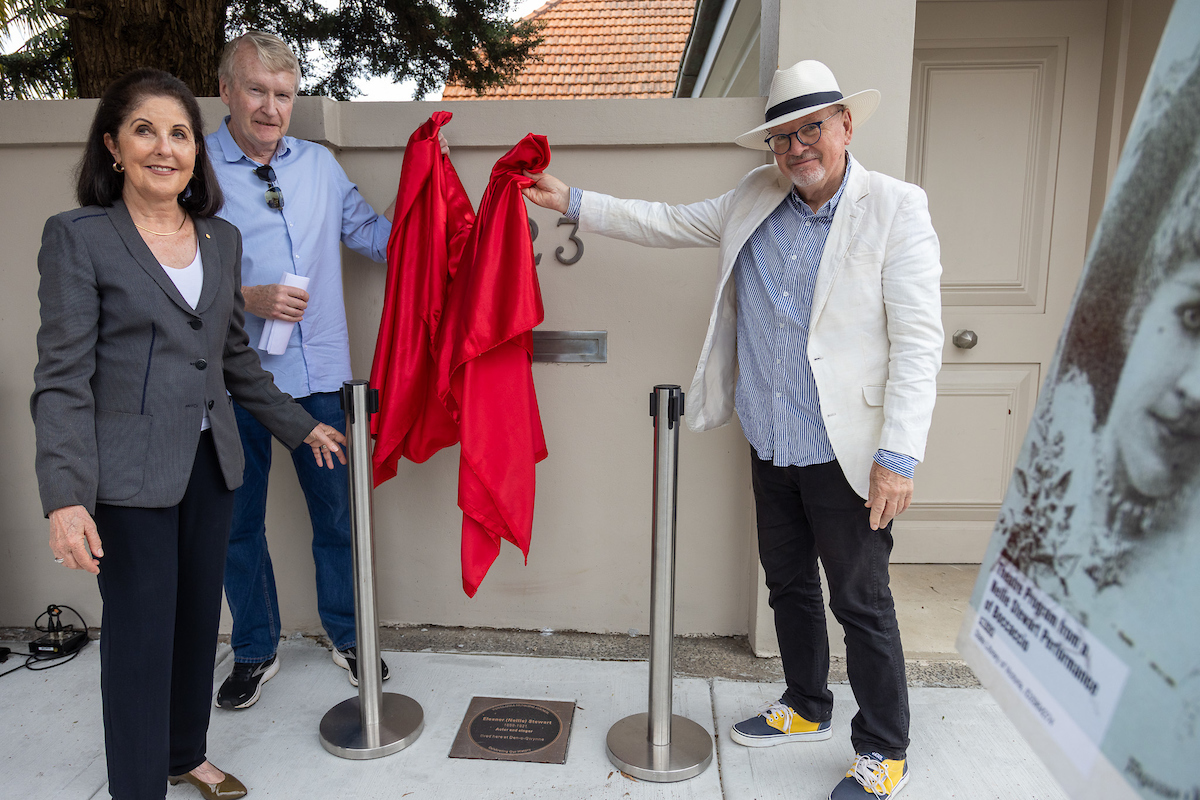
Plaque unveiling for actor and singer Nellie Stewart at 23 Wunulla Road, Point Piper on 31 October 2022. L-R Deputy Mayor Cr Isabelle Shapiro, Graham Shirley (Guest Speaker) and Graham Humphrey (nominator).
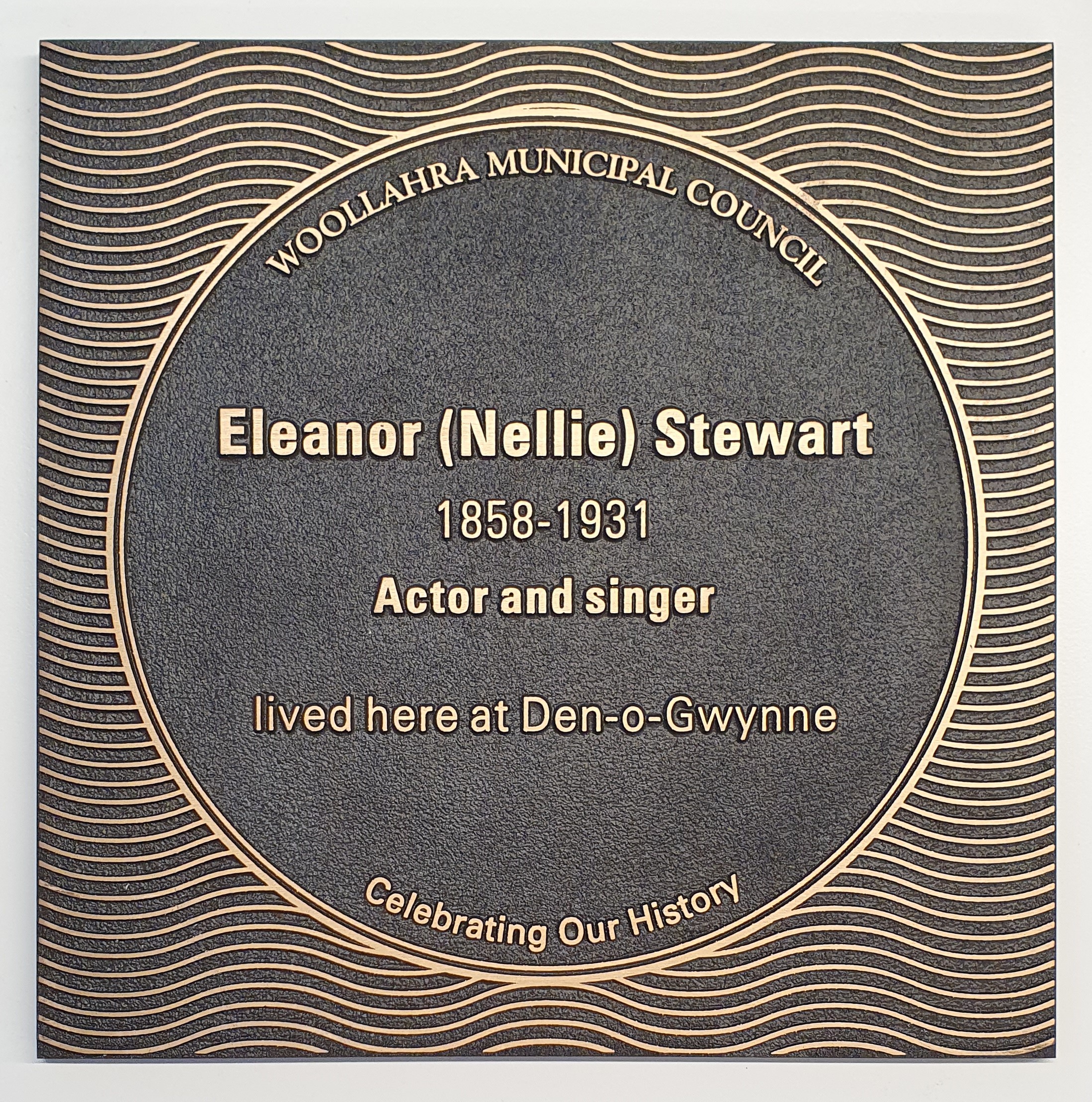
The plaque commemorating the life and career of Eleanor (Nellie) Stewart was unveiled on 31 October 2022 at 23 Wunulla Road, Point Piper. Her partner, George Musgrove, built Den-o-Gwynne for her in 1913 and named it after her most famous role as Nell Gwynne. Nellie Stewart lived there for several years after Musgrove’s death before selling the house c1920.
Read Graham Shirley's speech(PDF, 134KB)
Read an account of the friendship between the Robinson and Stewart families by Margaret Leask, great granddaughter of cartographer Herbert Robinson(PDF, 882KB) .
Gallery
Eleanor (Nellie) Stewart 20 November 1858 – June 1931
Born into theatre
Known throughout her career as “Nellie", Eleanor Towzey Stewart was born into a theatrical family on the 20th of November 1858, at Woolloomooloo, Sydney. Her father, Richard Stewart (formerly Towzey), was an English actor, comedian, entrepreneur and theatre manager. Her Irish-born mother Theodosia (née Yates, formerly Guerin) was the daughter of Richard and Mary Ann Yates, famously known for their work at the Drury Lane Theatre in London. Theodosia arrived in Australia with 'Mrs Clarke’s Opera Company' in 1840 and was a popular star in Hobart at the Theatre Royal. Nellie's parents met in Sydney after Theodosia’s husband, James Guerin, died leaving her with their two daughters Docie and Maggie. When Theodosia and Richard married in 1857, Richard Towzey changed his surname to Stewart and shifted his aspirations to the stage.
The Stewart family moved to Melbourne’s theatrical scene around 1860 where Nellie made her stage debut at the tender age of 5, alongside her father, in The Stranger at the Haymarket Theatre. The cast included family friends George Coppin, Charles Keene and his wife and the Stewarts, supporting Mr Simmonds, the sole lessee and manager of the theatre.
That first appearance did not determine my destiny – my birth did that – but it did set the seal on my calling and inclination. From that time on I never had any clear idea of my life or career, apart from the stage. Always I knew that I was fated for the theatre.’
Nellie Stewart, 1923
Growing up in Melbourne, Nellie attended the National Model and Training School and Grandtown Boarding House. Her formal education was punctuated with early, practical theatrical experiences throughout her childhood and as a young adult. Nellie had three siblings: older half-sisters Docie and Maggie, and Dick [Richard] (the youngest) who also participated in the theatre.
With her family on the stage
Nellie’s early career on the stage was spent with members of her immediate family. She would play boys or pages, sometimes wearing trousers, mostly without having any lines. An early appearance in a pantomime at the age of 16 drew this newspaper report:
Another novelty was Miss Nellie Stewart, a young lady who, although from her infancy associated with the Melbourne stage and who has played occasional minor parts, appears only now prominently for the first time. And of her it seems reasonable to predict a good future. She is handsome, lively, intelligent, speaks so as to be distinctly heard, dances with grace and humour and sings sufficiently well for average stage purposes
The Australasian Sketcher 23 January 1875
Beginning in 1877 at St George’s Hall in Melbourne the four children performed alongside their father in the unauthorized production of HMS Pinafore. Richard considered the talents of those under his roof to be similar to those of the family of George Seth and Maria Coppin, key figures of Australian theatre of the era, who became dear friends of the Stewarts in Melbourne. Richard made plans to take the Stewart family touring. He began by touring the family across Australia and Nellie’s first international performance was in New Zealand. Two years later the whole Stewart family toured India, England and the United States performing Garnet Walch’s material written particularly for them. This would be the beginning of Nellie’s performances on the world’s stages which spanned almost half of a century.
The family was very well received by their Indian audiences. Nellie would grace theatres across the globe already visited by other members of her family. In India she followed in her mother Theodosia’s footsteps.
“The style of entertainment and the dashing mode of impersonation adopted by the young ladies were new to Bombay and were welcomed for their originality, and when the company left the city everyone regretted that the visit could not be extended. After a brilliant and successful stay in Calcutta, the family on Saturday evening reappeared before a Bombay audience.
The Times of India,1879
The Stewarts went on to perform at the Crystal Palace outside London, before heading to New York. During this tour, Nellie learned extensively from her older sisters as well as her father about the stage and theatre. She recalled in her memoir “my father’s training never lost its hold on me. ‘You belong to your public from 8 till 11 nightly. Give them your best. You must work; work and rest, no play.’” Even Richard Stewart Jr came along and looked after the front of the house. It was during these formative years that Nellie formed her work ethic of continuous improvement, writing in her autobiography: “I was never satisfied myself with my performances; each night brought fresh efforts for improvement, and it was my delight when it was noticed and commented upon…”1
"Nellie Stewart, conscientious, versatile and hard-working, had undoubtedly established herself successfully in this new area of theatre."
Sweet Nell of Old Sydney. Marjorie Skill, 1974 2
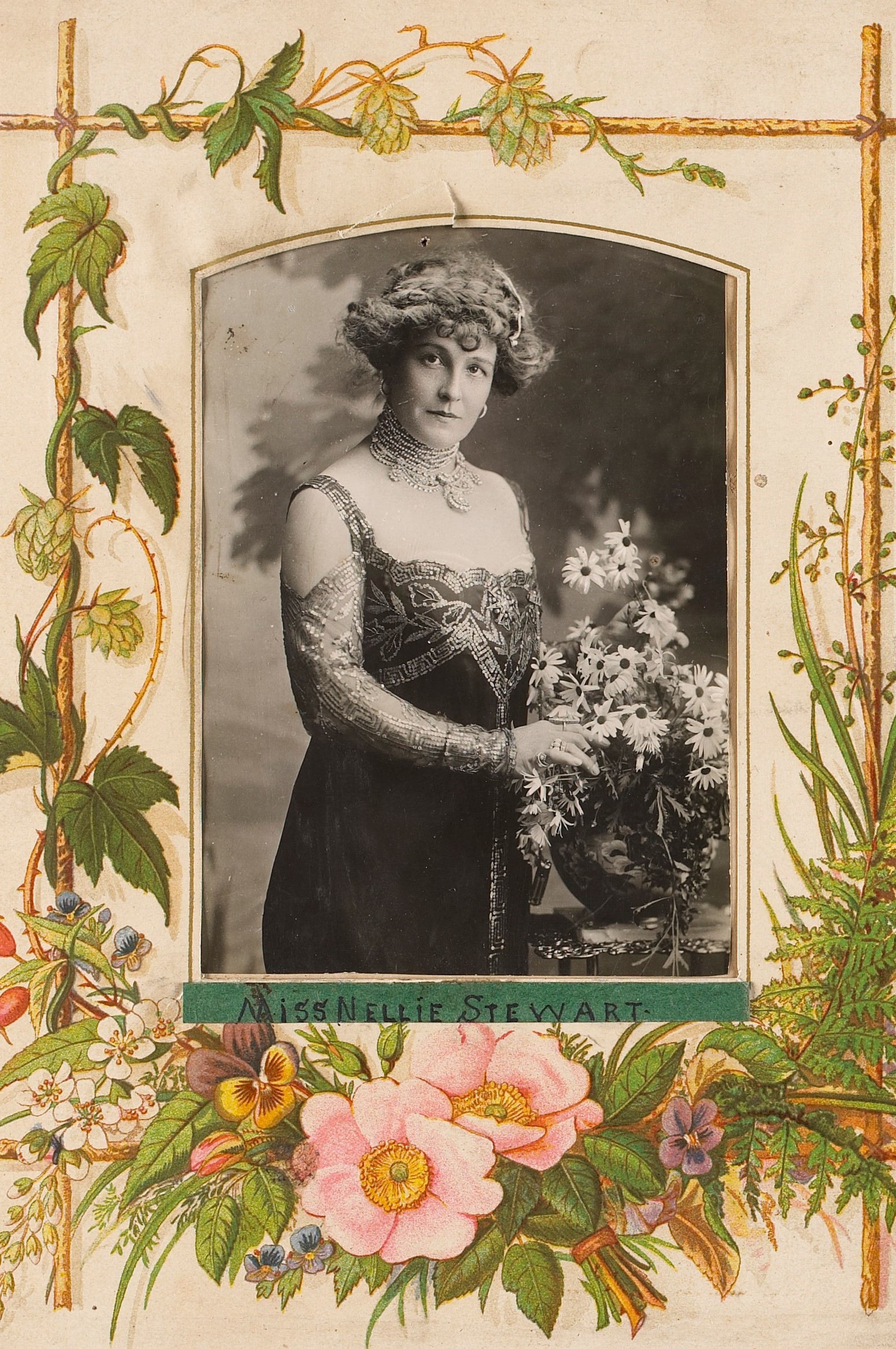
From Three portraits of Nellie Stewart mounted in a handmade frame c1887. Image: State Library of Victoria
As an actress, Nellie was very conscientious about her appearance, following a very strict health regime to maintain her youthful appearance. Nellie successfully played characters many years her junior throughout her career. Travelling with her family provided her with a viable entry into the craft. The family returned to Melbourne to participate in George Coppin’s production of Sinbad. This began Nellie taking on more leading rolls a young adult. However, the Australian theatrical community remained small and she often found herself playing opposite her half-sister, Maggie. For example in the summer 1883/4 Nellie starred as Jack in the grand comic Christmas pantomime Jack and the Beanstalk with Maggie playing her rival, Robin. The biggest difference at this point in her career was that Nellie was cast in primary roles in her own right, rather than as part of a family package. She was involved in theatre for so long, that she witnessed several changes including electrification.
“I can get again even the old smell of the theatre, the scent of gas and cigars that seemed to hang about all theatres before the electric-lighting came in, a scent that you get still, in a more pungent form and with a metallic admixture, on some of the great English railway stations. I don’t think cigars smell nearly as good as they used to, and I’m sure that the introduction of electricity has not been an unmixed benefit.”
My Life’s Story, Nellie Stewart, 1923, pg 16
Of course her familial ties within the theatre continued to influence her and her life was forever changed upon meeting George Musgrove. He was a producer in the Melbourne scene and Nellie would be the leading lady in his life both on and off the stage.3 Musgrove also came from a theatrical family and his introduction to theatre management was through an uncle. Nellie and George's partnership was mutually beneficial – she graced the stage with poise and he managed her career and helped create opportunities for her talent.4 Her national significance was most apparent when Musgrove was charged as Director of Amusements for the Royal visit to open the first Federal Parliament in 1901. Nellie performed “Australia” in her angelic, soprano voice to an audience that included the Duke of Cornwall and York.
Nellie and George travelled to London, Paris and Monte Carlo, returning to Melbourne refreshed. Nellie sang soprano in scores of light operas over her early career, but Musgrove believed she could also perform grand opera. In 1888 she appeared in his production of Faust at the Princess Theatre. That production had two cases of misfortune. First on opening night Federici, the baritone, suffered a fatal heart attack as he descended below the stage through a trapdoor. Regardless of this unfortunate accident, Nellie went on to sing the part of “Marguerite” for 24 straight nights. This so strained her voice that it was her first and last grand opera. For the rest of her career, Nellie took on lighter roles and branched out to dramas. By the turn of the twentieth century Nellie had performed in over 35 comic operas, pantomimes, and productions.
Sweet Nell
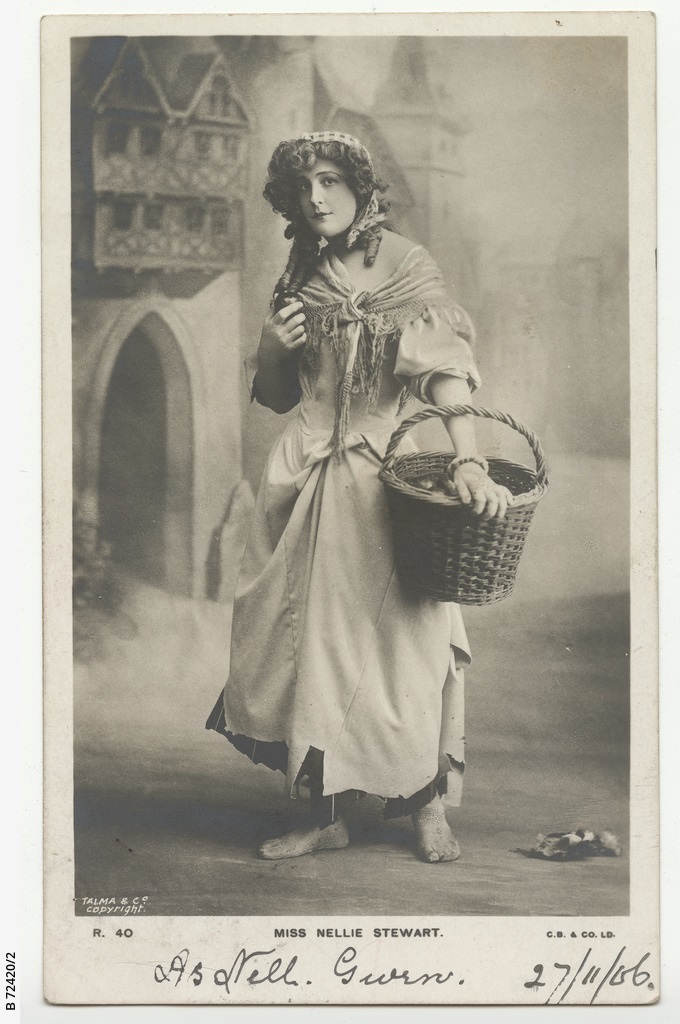
Nellie Stewart in her iconic role as "Nell Gwynne" in Sweet Nell of Old Drury. Image: Talma Studios. State Library of South Australia B-72420-2
The most famous character Stewart played over the last three decades of her life was that of “Nell Gwynne” - a persona that would be quintessentially hers until her death. Paul Kester, an American playwright, wrote Sweet Nell of Old Drury, a four-act play based on the life of the Restoration actress and mistress of King Charles II, Nell (Eleanor) Gwyn(ne) and the play was first performed in 1900 at the Haymarket Theatre, London. In 1902, Nellie Stewart played 'Sweet Nell' to Australian audiences at the Princess Theatre in Melbourne. The Melbourne season lasted five weeks and then moved to Tasmania, Adelaide and Sydney where another five week season opened in June. Nine years later (1911) Nellie Stewart appeared in her only movie screen appearance in “Sweet Nell of Old Drury.” Her performance at the age of 53 as an orange seller, wooed by King Charles II was so convincing that thousands saw it in its first week.5 A reporter to the screening described the audience’s reaction to her switch from stage to film.
“when the figure of Miss Nellie Stewart, as a bare-footed orange girl, was described in the distant perspective of a narrow rural track, there was great applause; and as she advanced into the foreground and coyly held out an orange, as if offering it to the audience, she had a fine reception"
"Sweet Nell of Old Drury". The Daily Telegraph 4 December 1911 pg 4.
Nellie continued to play the role of Nell for the remainder of her career. Depending on her financial circumstances, she could often rely on resurrecting the performance for an Australian audience. “She was almost 70 when she gave her last performance as Nell, still convincingly youthful and pneumatic enough to turn a king’s head.”6
Nellie had her London debut in February of 1892 at the Prince of Wales Theatre under the production of Musgrove. Her performance was met with great acclaim from newspapers of the time. “A most pleasant soprano singer and a vivacious actress.” A year later, their daughter Nancye Doris was born in Essex. Nancye too would go onto the stage following in the footsteps of other family members.7 The young Stewart family returned to Australia to help Nellie’s parents who had run into financial troubles. She performed in a troupe traveling across the country. The three of them returned to London in 1895 and she spent the next five years raising Nancye, with only periodic theatrical appearances. She fulfilled her life-long desire to appear at Drury Lane in The Forty Thieves during 1898, although in a building that had replaced the ones her great-grandparents and mother had graced. Both Nellie and George took separate trips to the US while based in London. Finances continued to be strained, but the small family managed to join a company that travelled back to Melbourne. Nellie starred as “Prince Charming” in Musgrove’s 1900 Christmas pantomime Cinderella.
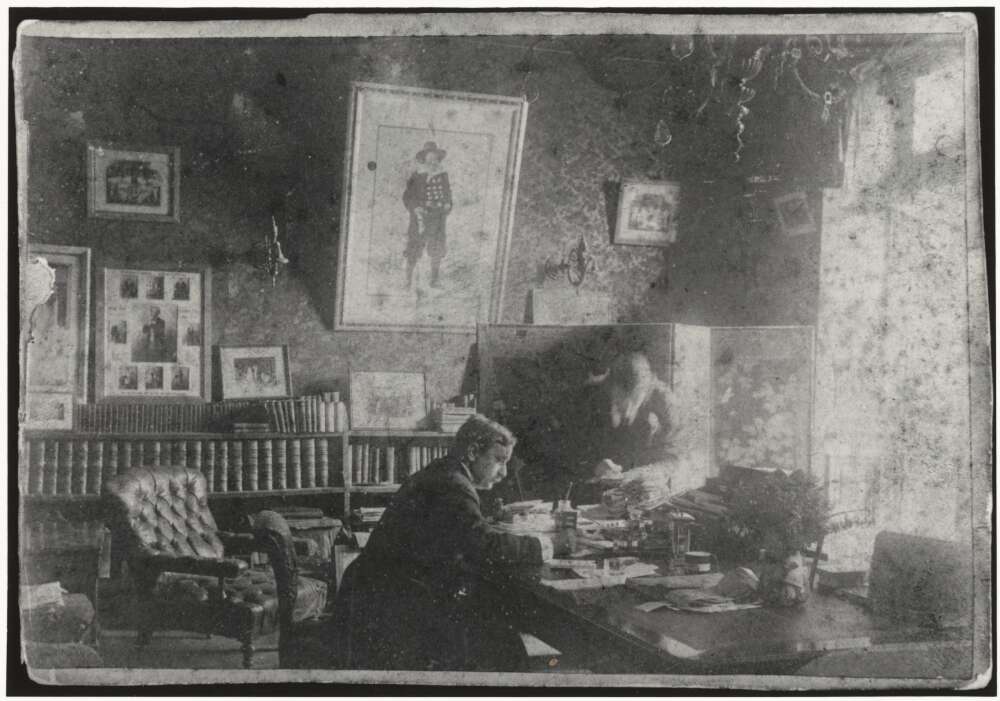
George Musgrove [at desk working] Princess Theatre, 1886. Image: National Library of Australia
That first decade of the twentieth century was full of highs and lows, but Nellie Stewart found success in her career with Sweet Nell and the honour of singing Charles Kenningham’s song at the first Parliament. Sweet Nell had become so notable that a horse with that name won the Caulfield Cup in 1903. Unfortunately these years also included the death of her father, in August of 1902, and her half-sister, Maggie, about a year later, but these familial heartaches did not interfere with Nellie’s giving nature and generosity to worthy causes and her public. She channelled her grief into helping to raise awareness and much needed funds for the Sydney Hospital in 1910. She sold donated gifts and lavender before the matinee for one hour and then oranges to the queue before performing on stage! With her efforts, £1400 was raised. The hospital made her a life governor and also named a cot in her honour.
The couple were often globe-trotting, at time finding themselves on opposite sides of the world. In 1905 Musgrove headed to America alone to prepare for a tour in that country starting in San Francisco while Nellie and her daughter headed to New Zealand. The family along with electricians and stagehands, sets and even a harpsichord set sail for the America tour of Sweet Nell. The 1906 earthquake destroyed all of the scenery for the production and their plans for touring across the country were ruined. Financially they scraped together what they could and returned to Australia.8 Nellie immediately dusted off some costumes and took to the road across Australia. She was welcomed with open arms in theatres she had visited earlier in her career.
More than 20 years have passed since Nellie Stewart won her way into the hearts of Australian theatre-goers, and the present generation fall in love with her just as much as did the last.
"Nellie Stewart" Barrier Miner 3 July 1909 p3
They travelled around New Zealand and Australia over the next few years but decided to stop touring and to build a house in Sydney. Musgrove returned to Sydney and purchased land to build a house for Nellie and their daughter Nancye. He spent all of their savings and funds from her father and sister to build a restaurant that never materialized, and in Nellie's absence, spent the remainder of their savings on Den-o-Gwynne in 1913.
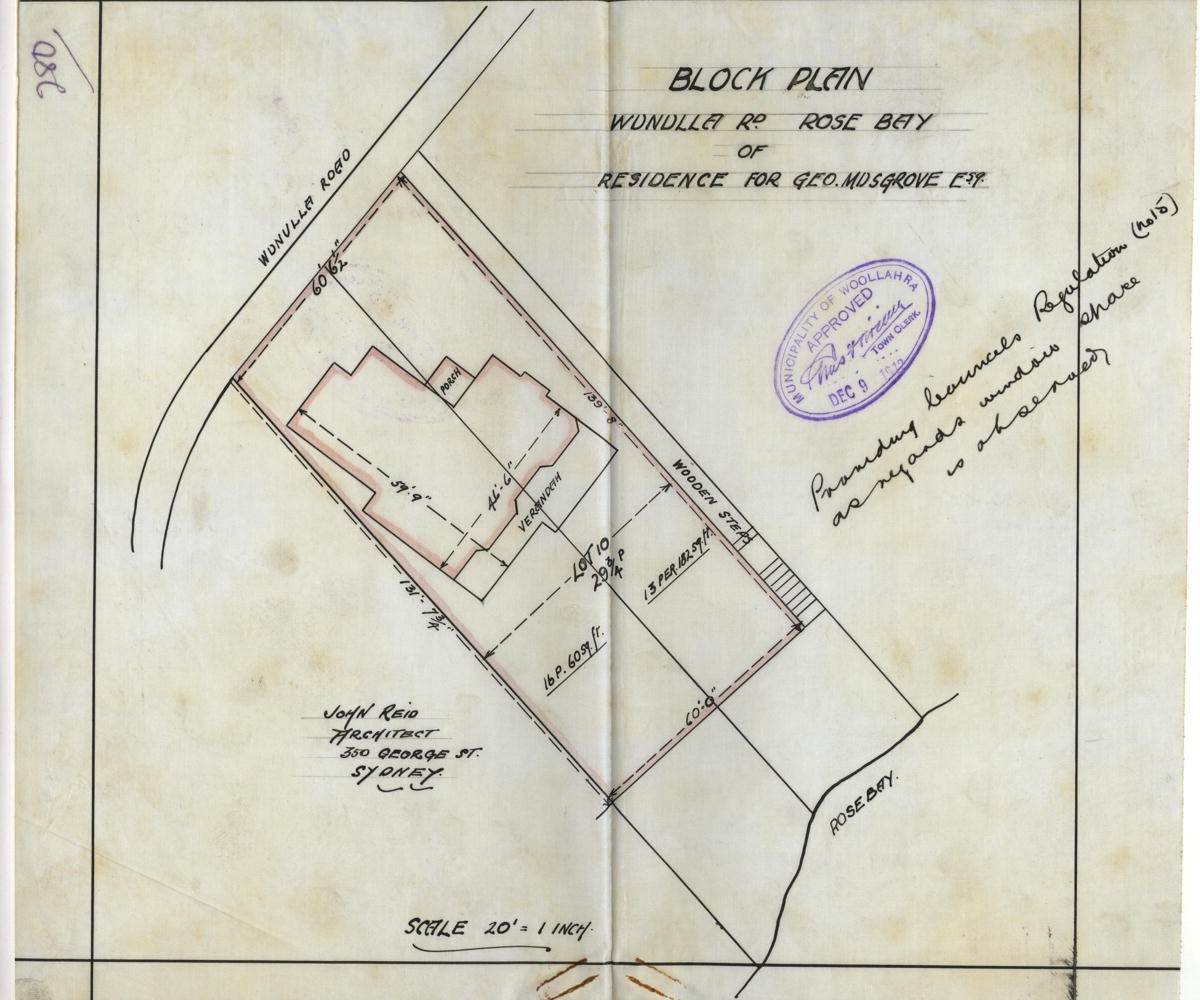
Block Plan from Building Application BA280/1912 for a Residence for George Musgrove, received by Woollahra Council 6 December 1912. Particulars for the application can be found here: BA280/1912(PDF, 984KB)
Their settled life in Point Piper was short lived as Musgrove fell ill with whooping cough. She described the financial heartache in her memoir: “I never talked to him of this last gigantic failure, or of all the money that had gone into it, but I tried to think what I could do to help him.” Finances were very tight and Nellie returned to the public eye to bring in some funds. She used her sewing skills and pulled a few purse and heart strings to prepare a New York production for Australian audiences, but their efforts to open at the end of August 1914 were interrupted by the declaration of World War 1. She continued to perform onstage and toured around Australia with various productions. All the while, Musgrove’s health continued to decline.
Nellie Stewart, Sydney’s darling, one of the daintiest, prettiest and most appealing actresses. Her house, “Den o’ Gwynne,” was the joy of her heart, and, like many other artists, her greatest pleasure was her home.
Point Piper, Past and Present, G Nesta Griffiths, 1970 9
Nellie’s half-sister Docie took over the housekeeping at Den-o-Gwynne, while Nellie cared for George and performed for additional income. She returned to New Zealand for another tour and then onto Adelaide, both without George. Musgrove died on 21st of January in 1916, and Nellie was utterly devastated. She described coming in from the garden at Den-O-Gwynne and commenting to him after lunch about some flowers she had given him for his birthday. He was unable to respond and Nellie called it the worst day of her life. Nancye came to comfort her mother, but being surrounded by his memory in the house made it difficult to move on. “My Nancye was with me. In her, my grief was crowned with consolation. I often wonder what might have become of me but for her devotion and care.”10 Nellie also received encouragement from her friend Hugh D McIntosh, who convinced her to return to performance in a re-crafting of the story of Sweet Nell into into a one-act play.
In 1920 Nellie Stewart sold Den-o-Gwynne at Point Piper, and after selling some film rights to Hollywood, purchased a house in Mosman. The Nellie Stewart School of Acting began taking students in Sydney in 1921 after it received the public support of McIntosh, which allowed her to focus on recovering from her broken heart. Writing her memoirs also took up much of her time. She continued with her charity performances, including one in 1926 for the hospital, and penned a plea to her public for additional funds for radium needles to help treat cancer patients. Nellie resurrected her famous role and spent time in 1927 between Melbourne and Sydney as Sweet Nell once again. Her last public performance was with her daughter performing the balcony scene of Romeo & Juliet three days before her death on 20th of June 1931.
Newspapers reported that 'a large number of mourners had lined the route between her home at Clifton Gardens [Mosman] and St. James's Church, which was crowded for the service'. She was cremated in Sydney and her ashes sent to Melbourne and interred at the Boroondara General Cemetery at Kew, alongside her father.
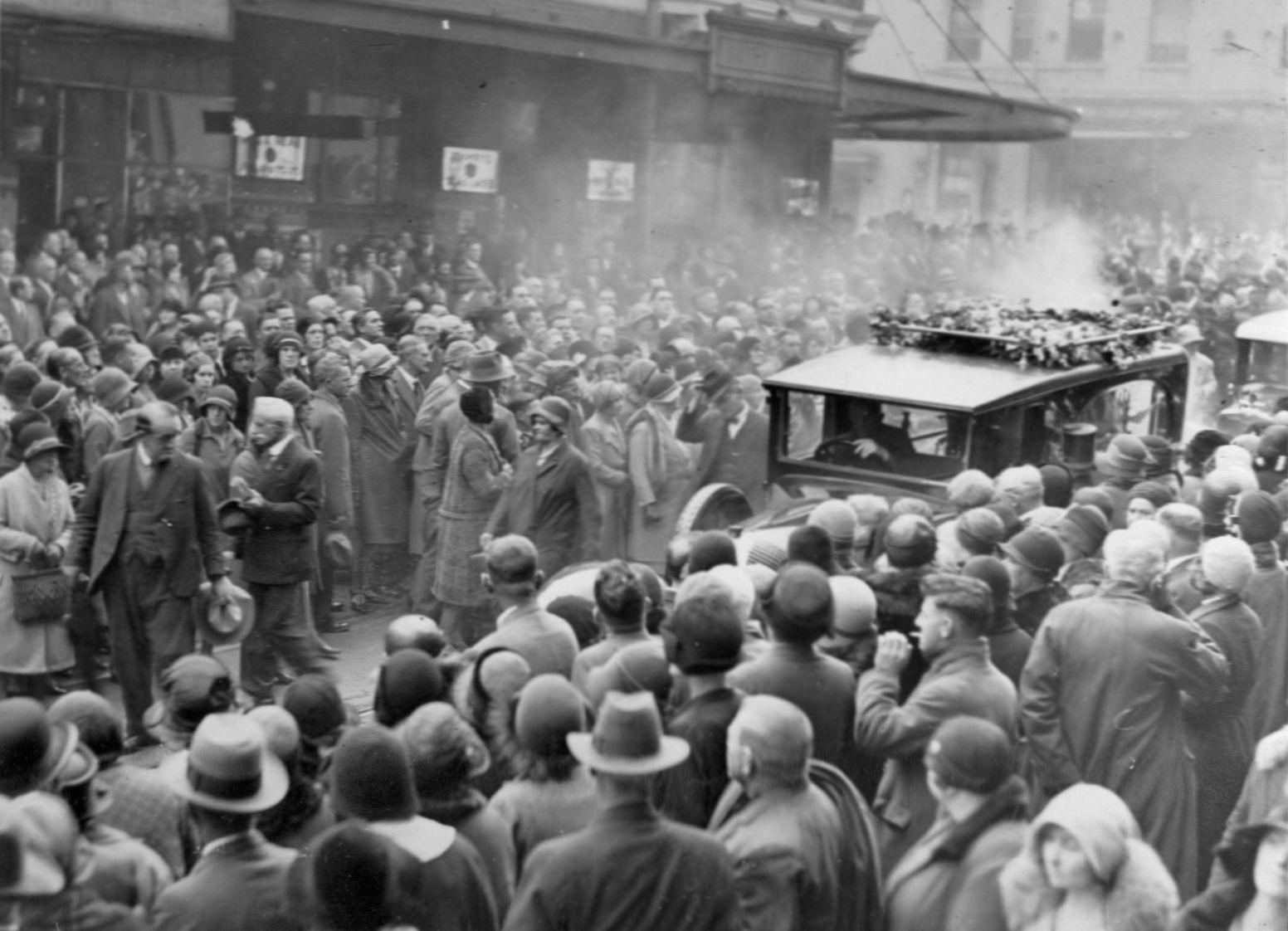
Miss Nellie Stewart funeral in Sydney 1931. Photographer: Mr Fred Port Image: from the collections of the Queensland Museum H4113.
Nellie Stewart was an early Australian cultural icon, well known during her lifetime and an influence on life beyond the theatre, including the worlds of fashion and music.
Nellie Stewart was given a bangle by George Musgrove which she wore on her upper arm for the rest of her life. This fashion statement became known as “Nellie Stewart bangles” and was swiftly emulated by thousands of women all over Australia.11
Stewart also inspired music. In c1909 Maisie Rowlands respectfully dedicated the “Nellie Stewart Waltz” to her. There were several other pieces written for her soprano voice or dedicated to her in the early twentieth century. Her voice is retained in the collection of the State Library of New South Wales, recorded a few months before her death. This recording includes her singing “Who’ll buy my oranges?” as well as parts of Sweet Nell.
Nellie Stewart had completed her memoir with the following thought:
I am still steadfast in my determination to do my utmost best always. Resolve will meet no rocks, but it can scale them. And so, friends of mine, au voir. Let me take my leave of you in the lasts words of “Sweet Nell” – ‘Memory will be my happiness – For you are enshrined there.’
Nellie Stewart, 1924
In March 1931 she made her last recording - an Address To Her Public.
“It is with a peal of joy that I look back on the wonderful affection shown me in so many ways by you, my friends. I am so very grateful, my dear, dear public.”
Nellie Stewart, 193112
Nellie Stewart's contributions to Australian acting and theatre have been commemorated in a variety of ways. Only two years after her death, and through the 1930s the “Nellie Stewart Memorial Cup” recognized the best performance of an Australian-written play in Junior Theatre League drama contests.13 In Melbourne where she first appeared as “Sweet Nell of Old Drury”, the Princess Theatre has commemorated Nellie and her iconic role by naming their confectionary shop “Sweet Nell’s.” To commemorate the 70th anniversary of Stewart’s death, the Victorian Arts Centre in Melbourne mounted a major exhibition in 2001.

Australia Post issued two stamps in 1989 marking 200 years since the first theatrical performance in Australia. Sue Passmore designed stamps featuring on-and-off screen pairings for stage and screen. Nellie Stewart and J C Williamson graced the $1 postage stamp as part of a collection of four stamps. Williamson had owned several Australian theatres and companies where Stewart performed.14 The design commemorated a joint contribution to the theatre that was recognised and valued at a national level.
During her life, Nellie utilized her cultural capital to support a variety of charitable organizations, often appearing at fundraisers and lending her celebrity status to draw a crowd and elicit much-needed funds. In 1910 she helped Sydney Hospital raise £3000 that enabled the purchase of radium. A year later, she directed a carnival to help celebrate the hospital’s centenary.15
Following Nellie Stewart's death, fans and family chose to honour her memory and carry on her charitable endeavours. The Nellie Stewart Memorial Club was founded in her honour, aided in its endeavours by a fund-raising arm known as the Nellie Stewart Old Drury Club. The Memorial Club first focused its energy in 1936 on an extensive rose garden of over 2,000 bushes in the Sydney Botanic Gardens. Two years later, in 1938, they funded a bronze plaque to include a cameo portrait of Stewart by H C Eccles that still remains in the gardens in 2021.
The memorial bronze plaque of NELLIE STEWART, which will be unveiled by Lady Wakehurst in the Garden of Memory, Botanic Gardens, on June 21. The plaque will be set in the pergola, which is surrounded by more than 2,000 rose trees, and has already been given to the citizens by the Nellie Stewart Memorial Club. Lady Wakehurst will attend the Garden of Memory luncheon to be held at the Carlton Hotel on June 21, after which the party will adjourn to the Botanic Gardens for the unveiling of the plaque, which will be on view in the windows of Proud's, Ltd, until that date.
'Nellie Stewart Memorial Plaque' The Sydney Morning Herald, June 11, 1938 p. 11
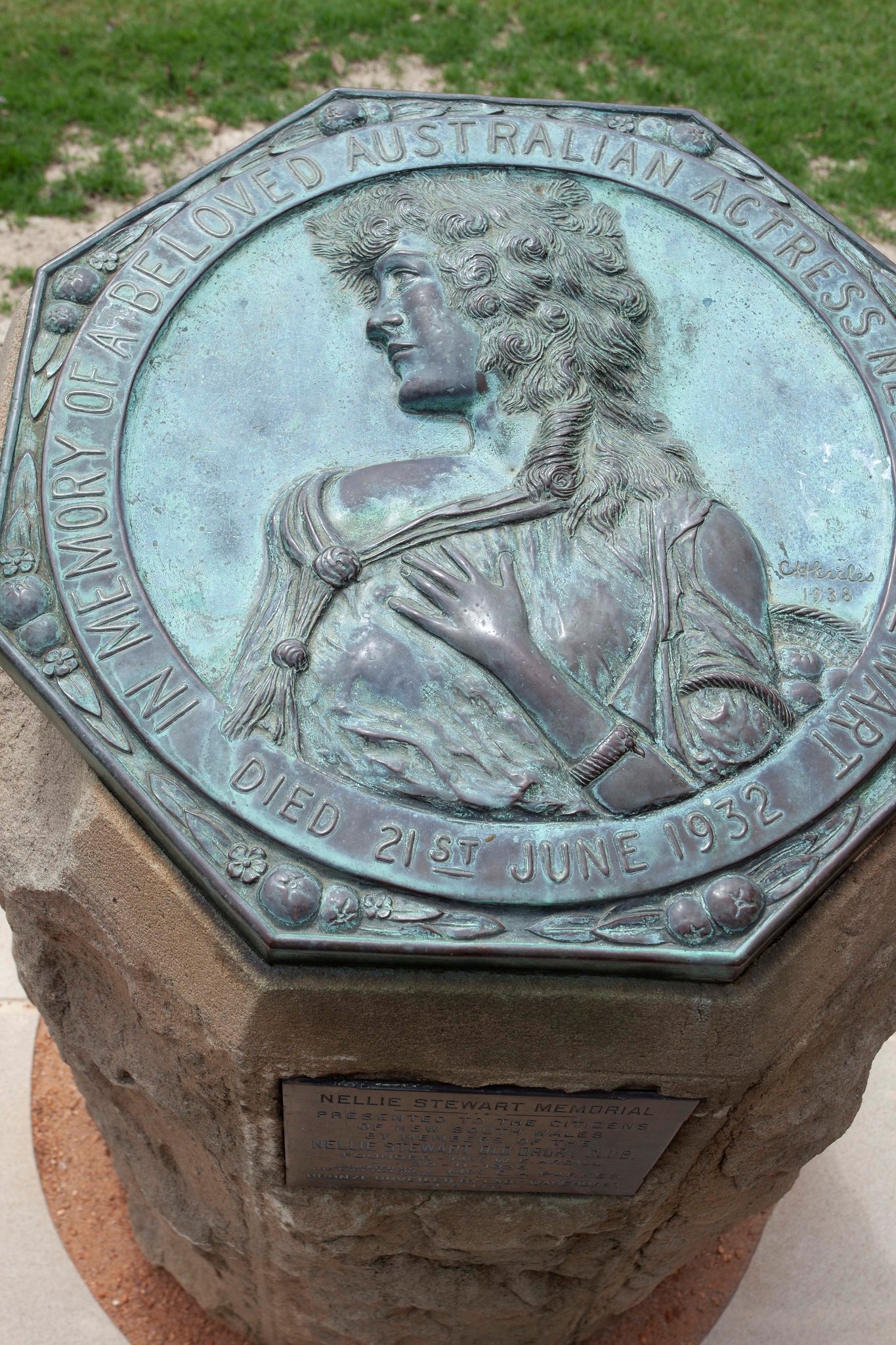
'IN MEMORY OF A BELOVED AUSTRALIAN ACTRESS NELLIE STEWART DIED 21ST JUNE 1932 [sic]'. Nellie Stewart Memorial Plaque. Image: Royal Botanic Gardens Sydney Flikr
The club went on to celebrate its 21st birthday on the 13 of April 1955 with a benefit “For sweet Nell and sweet charity.” All proceeds would go to the Victor Maxwell House Nursery for Blind Children, 1 Chester Street, Woollahra. The festivities included a program filled with items from her “varied and extensive repertoire.” The club also funded a memorial plaque in St James Anglican Church, along its north wall (no.125). The plaque reads “In loving memory of Nellie Stewart beloved actress who was baptized in this church and buried from its precincts, born 20 November, 1858 died June, 1932 [sic] ‘Memory will be my Happiness,’ Sweet Nell of Old Drury. Erected by members of the Nellie Stewart Memorial Club.”
Australasian Radio Relay League (1938-09-30). Memories Of... NELLIE STEWART (30 September 1938). In The wireless weekly : the hundred per cent Australian radio journal. 32 (14).
Cooper, Ross. 'Stewart, Eleanor Towzey (Nellie) (1858–1931)', Australian Dictionary of Biography, National Centre of Biography, Australian National University https://adb.anu.edu.au/biography/stewart-eleanor-towzey-nellie-8663
Kumm, Elisabeth. Sweet Nell. Theatre Heritage Australia - On Stage Magazine (01 March 2022) https://theatreheritage.org.au/on-stage-magazine/profiles/item/769-sweet-nell
Porter, Hal Stars of Australian Stage and Screen Rigby Limited, Adelaide, 1965. Woollahra Libraries Local History Collection LH 792.0994 POR.
Shirley, Graham, 'The lost film of Nellie Stewart', State Library of New South Wales 2020 https://www.sl.nsw.gov.au/stories/lost-film-nellie-stewart
Skill, Marjorie. Sweet Nell of Old Sydney, Urania Publishing, 1974.
Stewart, Nellie. Nellie Stewart: My Life’s Story, John Sands, 1923.
Van Straten, Frank ‘Nellie Stewart – Fated for the Theatre’, in Stages, June 1991.
Van Straten, Frank Hall of Fame Live Performance Australia 2007 https://liveperformance.com.au/hof-profile/nellie-steward-1858-1931/
APPENDIX
PROGRAMS HELD National Library of Australia starring Nellie
- [1889] The Yeomen of the Guard Season commencing 20 April New Princess Theatre, Melbourne (Victoria) Starring Mr T. Grundy, Mr W. Elton and Miss Nellie Stewart 1 program
- 1893 The Mikado Season commencing 21 October Lyceum Theatre, Sydney (New South Wales) Starring Miss Nellie Stewart, Mr William Rosevear and Mr Howard Vernon 1 program – incomplete (fragment pasted onto board)
- 1893 The Pirates of Penzance Season commencing 9 December Lyceum Theatre, Sydney (New South Wales) Starring Miss Nellie Stewart, Mr Howard Vernon, Mr Joseph Tapley and Mr Charles Ryley 1 photocopy of program
PANTOMIMES produced by J.C. Williamson or produced in J.C. Williamson theatres starring Nellie
- 1885-86 Cinderella. Season commencing 26 December Theatre Royal, Sydney (New South Wales) Starring Miss Nellie Stewart
- 1893-94 Beauty and the Beast. Season commencing 26 December Lyceum Theatre, Sydney (New South Wales) Starring Nellie Stewart and Mr George Lauri Also –Miss Florence Young and Mr Arthur Lissant
- 1901 The Scarlet Feather. Season commencing 20 February Theatre Royal, Sydney (New South Wales) Starring Miss Nellie Stewart
- 1902 Sweet Nell of Old Drury. Season commencing 14 June Theatre Royal, Sydney (New South Wales) Starring Miss Nellie Stewart
- 1904 Pretty Peggy. Season commencing 8 October Princess Theatre, Melbourne (Victoria) Starring Miss Nellie Stewart
- 1909 Sweet Kitty Bellairs. Season commencing 10 April Princess Theatre, Melbourne (Victoria) Starring Nellie Stewart
- 1909 As You Like it. Season commencing 14 July Her Majesty’s Theatre, Sydney (New South Wales) Starring Nellie Stewart
- 1909 As You Like it. Season commencing 23 October His Majesty’s Theatre, Brisbane (Queensland) Starring Nellie Stewart
- 1910 When Knighthood was in Flower. Season commencing 30 May Crystal Theatre, Broken Hill (New South Wales) Starring Nellie Stewart
- 1910 When Knighthood was in Flower. Season commencing 13 August Theatre Royal, Sydney (New South Wales) Starring Nellie Stewart
- 1910 Sweet Nell of Old Drury. Season commencing 3 September Theatre Royal, Sydney (New South Wales) Starring Nellie Stewart
- 1914 Du Barry. Season commencing 14 August Theatre Royal, Sydney (New South Wales) Starring Nellie Stewart
- 1914-15 Dorothy o’ the Hall. Season commencing 26 December Theatre Royal, Sydney (New South Wales) Starring Nellie Stewart
- 1927 Sweet Nell of Old Drury. Season commencing 5 March Theatre Royal, Melbourne (Victoria) Starring Nellie Stewart
- 1927 Sweet Nell of Old Drury. Season commencing 9 April Criterion Theatre, Sydney (New South Wales) Starring Nellie Stewart
- 1929 Sweet Nell of Old Drury. Season commencing 30 March Theatre Royal, Adelaide (South Australia) Starring Nellie Stewart
- 1929 Sweet Nell of Old Drury. Season commencing 20 April Comedy Theatre, Melbourne (Victoria) Starring Nellie Stewart
- 1930 Romance. Season commencing 19 April Comedy Theatre, Melbourne (Victoria) Starring Nellie Stewart
Footnotes
1 Nellie Stewart, My Life’s Story, John Sands, 1923, State Library of NSW, pg 57.
2 Marjorie Skill, Sweet Nell of Old Sydney, Urania Publishing, 1974 State Library of NSW, pg 34.
3 Nellie and Richard Goldsbrough Row were married at Scots Church manse, Sydney, on 26 January 1884 and their union dissolved in 1901. In her memoir she described that wedding day as “tragic” and the week after the marriage she set sail for New Zealand, seeming to have never wished the union. Amazingly the two are buried near each other in the Melbourne cemetery.
4 Although mutually beneficial, neither person was financially savvy, particularly George. Financial woes were peppered throughout her memoir, My Life’s Story, but one particular quite stood out about that trouble. “Of what use was all the money that for three years had been pouring in? It benefitted neither of us. Litigations – unfair dealings – and all went. Thousands and thousands to pay it off, for George was honor itself. So we were once more left poor – oh! so poor none will know – and nothing looming for the future.” Pg 236
5 Andrew Pike and Ross Cooper, Oxford Australian Film 1900-1977 Oxford University Press, Melbourne, 1998 Pg 30 part of the Woollahra Library Local History Collection LH791.430994/PIK.
6 Pg 8 Warden, Ian “Nellie Stewart” National Library of Australia News, December 2008 pg 7-10. https://webarchive.nla.gov.au/awa/20120205171953/http://pandora.nla.gov.au/pan/131760/20120120-0944/www.nla.gov.au/pub/nlanews/2008/dec08/story-2.pdf
7 Nancye Doris Lynton had two sons and died 8 August 1973 in Neutral Bay.
8 In Musgrove’s will, he wrote “I desire to place on record the fact that the share of my estate bequeathed to Nellie Stewart is in every right her own, she having by years of hard work without payment greatly advanced my interests which without her aid I would probably have no estate whatever. In explanation of the above distribution of my property and estate I have done what I considered fair having regard to the situation as a whole.” His will also referenced his wife Emily Musgrove and his three daughters Lily Woenarski, Rose and May Musgrove. Nellie Stewart’s will provides that her family’s grave and that of Musgrove should be cared for by her estate. (Skill, Sweet Nell of Old Sydney)
9 G Nesta Griffiths, 1970 Point Piper, Past and Present Pg 107 part of the Woollahra Library Local History collection.
10 My Life’s Story, pg 244.
11 Annita Boyd, “The Private and Public Life of Nellie Stewart’s Bangle” Journal of Popular Romantic Studies October 2014 http://www.jprstudies.org/2014/10/the-private-and-public-life-of-nellie-stewarts-bangleby-annita-boyd/
12 Nellie Stewart, 'Sweet Nell of Old Drury', Extracts and Speech, 24 February 1931. (24). https://search.sl.nsw.gov.au/permalink/f/1cvjue2/ADLIB110644889 See an article published about these recordings at https://www.sl.nsw.gov.au/stories/lost-film-nellie-stewart.
13 “Junior theatre league” Sydney Morning Herald, 11 June 1934, p 5 http://nla.gov.au/nla.news-article17102447; “Nellie Stewart” Sydney Morning Herald supplement, 8 March 1934, p 2; and “Junior playwright” Australian Women’s Weekly, 7 December 1935, p 33.
14 Image of stamp from http://www.australianstamp.com/images/large/0018130.jpg
15 1911, 100 years, Sydney Hospital centenary souvenir : monster continental carnival under the direction of Miss Nellie Stewart ; promoted by Hugh D. McIntosh Ross Bros Sydney https://nla.gov.au/nla.cat-vn3033720
New plaques are added based on nominations from the community, which are then assessed against selection criteria and researched by a Local History Librarian.
Find out more and nominate a person or event for a plaque.